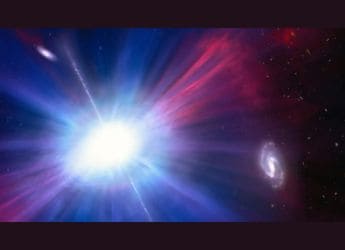- Home
- Science
- Science News
- Gravity Telescope Conceptual Imaging Technique Described by Stanford Scientists: What It Can Do
Gravity Telescope Conceptual Imaging Technique Described by Stanford Scientists: What It Can Do
The prospective gravity telescope technology could permit significantly more advanced astronomical imaging than is currently possible.

Photo Credit: Stanford University/ Alexander Madurowicz
An example of a reconstruction of Earth, using the ring of light around the Sun
The first exoplanet was discovered in 1992. Since then, astronomers have discovered almost 5,000 planets orbiting other stars. However, whenever a new exoplanet is discovered, little information is available about it. All that is known is that the exoplanet exists and it has a few characteristics. Everything else, though, remains a mystery. To address this issue, Stanford University astrophysicists have been working on a new conceptual imaging technique that would be 1,000 times more precise than the strongest imaging technology now in use. Scientists could theoretically manipulate the warping effect of gravity on space-time, known as lensing, to develop imagery far more advanced than any currently available.
The researchers appear to have figured out how to use solar gravitational lensing to see planets outside our solar system. The scientists' prospective technology could permit significantly more advanced astronomical imaging than is currently possible.
Scientists could use the Sun's gravitational field to magnify light from an exoplanet passing by aligning a telescope, the Sun, and the exoplanet in a line, with the Sun in the middle.
A gravitational lens, unlike a magnifying glass with a curved surface that bends light, has a curved space-time that allows it to image far away objects.
The researchers published their findings in the May 2 edition of The Astrophysical Journal.
The proposed method, though, would necessitate more advanced space travel than is now possible. Nonetheless, the researchers believe that the concept's promise, as well as what it could tell about other worlds, merits further investigation, and development.
It wasn't until 1919, during a solar eclipse when gravitational lensing was experimentally detected. Scientists were able to spot stars near the Sun offset from their known positions due to the Moon blocking the Sun's light. This was the first observational evidence that Albert Einstein's theory of relativity was right, and it was unequivocal proof that gravity could bend light.
Bruce Macintosh, a physics professor at the School of Humanities and Sciences at Stanford and deputy director of the Kavli Institute for Particle Astrophysics and Cosmology, said that using this technology, they want to be able to take photos of planets orbiting other stars that are as good as the photos they can take of planets in the solar system. The researchers hope to take a photo of a planet 100 light-years away that has the same impact as a photo of the Earth taken by Apollo 8.
Get your daily dose of tech news, reviews, and insights, in under 80 characters on Gadgets 360 Turbo. Connect with fellow tech lovers on our Forum. Follow us on X, Facebook, WhatsApp, Threads and Google News for instant updates. Catch all the action on our YouTube channel.
Related Stories
- Samsung Galaxy Unpacked 2025
- ChatGPT
- Redmi Note 14 Pro+
- iPhone 16
- Apple Vision Pro
- Oneplus 12
- OnePlus Nord CE 3 Lite 5G
- iPhone 13
- Xiaomi 14 Pro
- Oppo Find N3
- Tecno Spark Go (2023)
- Realme V30
- Best Phones Under 25000
- Samsung Galaxy S24 Series
- Cryptocurrency
- iQoo 12
- Samsung Galaxy S24 Ultra
- Giottus
- Samsung Galaxy Z Flip 5
- Apple 'Scary Fast'
- Housefull 5
- GoPro Hero 12 Black Review
- Invincible Season 2
- JioGlass
- HD Ready TV
- Laptop Under 50000
- Smartwatch Under 10000
- Latest Mobile Phones
- Compare Phones
- Honor Win RT
- Honor Win
- Xiaomi 17 Ultra Leica Edition
- Xiaomi 17 Ultra
- Huawei Nova 15
- Huawei Nova 15 Pro
- Huawei Nova 15 Ultra
- OnePlus 15R
- Asus ProArt P16
- MacBook Pro 14-inch (M5, 2025)
- OPPO Pad Air 5
- Huawei MatePad 11.5 (2026)
- Xiaomi Watch 5
- Huawei Watch 10th Anniversary Edition
- Acerpure Nitro Z Series 100-inch QLED TV
- Samsung 43 Inch LED Ultra HD (4K) Smart TV (UA43UE81AFULXL)
- Asus ROG Ally
- Nintendo Switch Lite
- Haier 1.6 Ton 5 Star Inverter Split AC (HSU19G-MZAID5BN-INV)
- Haier 1.6 Ton 5 Star Inverter Split AC (HSU19G-MZAIM5BN-INV)

















